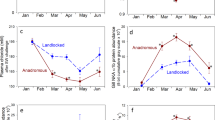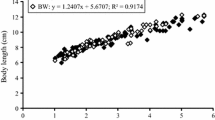Abstract
Use of estuaries and oceans by salmonids varies greatly, from no use in nonanadromous species, to movement toward the sea soon after hatching and emergence in some Pacific salmon. This variation is accompanied by large differences in the ontogeny of salinity tolerance among salmonids. Some species acquire increased salinity tolerance early in development, whereas others develop this characteristic much later, indicating there is a heterochrony (change in timing) in the development of salinity tolerance in salmonids. The basic physiological mechanisms for ion regulation in seawater (such as increased gill chloride cells, gill Na+,K+-ATPase activity, membrane permeability, and drinking rate) are common to all salmonids. What determines the differences in salinity tolerance among the salmonids is not the basic mechanisms for salt secretion but the environmental and ontogenetic control of these mechanisms. In salmonids such as pink and chum salmon that enter seawater soon after emergence, acclimation to seawater may be controlled largely by internal (ontogenetic) information. In smolting salmonids that acquire increased salinity tolerance 1–2 yr after hatching, photoperiod is the dominant environmental cue. In nonsmolting species that migrate 2–3 yr after hatching, salinity itself may be the primary stimulus for salt secretory mechanisms. Physiological changes triggered by developmental and environmental cues are mediated by endocrine factors. Treatments with cortisol, growth hormone, and insulin-like growth factor I have been shown to increase seawater tolerance of salmonids, whereas prolactin is inhibitory. Differences in developmental patterns of endocrine activity (such as secretion, binding proteins, and receptors) are hypothesized to be responsible for the differences in timing (heterochrony) of increased salinity tolerance among and within salmonid species.
Similar content being viewed by others
Literature Cited
Arnesen, A. M., M. Halvorsen, andK. J. Nilssen. 1992. Development of hypoosmoregulatory capacity in Arctic char (Salvelinus alpinus) reared under either continuous light or natural photoperiod.Canadian Journal of Fisheries and Aquatic Sciences 49:229–237.
Besner, M., andD. Pelletier. 1991. Adaptation of the brook trout,Salvelinus fontinalis, to direct transfer to sea water in spring and summer.Aquaculture 97:217–230.
Boeuf, G. 1993. Salmonid smolting: A pre-adaptation to the oceanic environment, p. 105–135.In J. C. Rankin and F. B. Jensen (eds.), Fish Ecophysiology, Chapman Press, London.
Clarke, W. C., H. Lundqvist, andL.-O. Eriksson 1985. Accelerated photoperiod advances seasonal cycle of seawater adaptation in juvenile Baltic salmon,Salmo salar L.Journal of Fish Biology 26:29–35.
Clarke, W. C., J. E. Shelbourn, T. Ogasawara, andT. Hirano. 1989. Effect of initial daylength on growth, seawater adaptability and plasma growth hormone levels in underyearling coho, chinook, and chum salmon.Aquaculture 82:51–62.
Clarke, W. C., R. E. Withler, andJ. E. Shelbourn. 1994. Inheritance of smolting phenotypes in backcrosses of hybrid stream-type x ocean-type chinook salmon (Oncorhynchus tshawytscha).Estuaries 17:13–25.
Conte, F. P., H. H. Wagner, J. Fessler, andC. Gnose. 1966. Development of osmotic and ionic regulation in juvenile coho salmon (Oncorhynchus kisutch).Comparative Biochemistry and Physiology 18:1–15.
Conte, F. P., andH. H. Wagner. 1965. Development of osmotic and ionic regulation in juvenile steelhead trout,Salmo gairdneri.Comparative Biochemistry and Physiology 14:603–620.
Duston, J., R. L. Saunders, andD. E. Knox. 1991. Effects of increases in freshwater temperature on loss of smolt characteristics in Atlantic salmon (Salmo salar).Canadian Journal of Fisheries and Aquatic Sciences 48:164–169.
Evans, D. H. 1979. Fish, p. 305–390.In G. M. O. Maloiy (ed.), Osmotic and Ionic Regulation in Animals, Vol. 1. Academic Press, London.
Grewe, P. M., N. Billington, andD. N. Hebert. 1990. Phylogenetic relationships among members ofSalvelinus inferred from mitochondrial DNA divergence.Canadian Journal of Fisheries and Aquatic Sciences 47:984–991.
Hoar, W. S. 1988. The physiology of smolting salmonids, p. 275–343.In W. S. Hoar and D. J. Randall (eds.), Fish Physiology, Vol. XIB. Academic Press, New York.
Hutchings, J. A., andD. W. Morris. 1985. The influence of phylogeny, size and behaviour on patterns of covariation in salmonid life history.Oikos 45:118–124.
Jarvi, T. 1990. Cumulative acute physiological stress in Atlantic salmon smolts: The effect of osmotic imbalance and the presence of predators.Aquaculture 89:337–350.
Johnston, C. E., andR. L. Saunders. 1981. Parr-smolt transformation of yearling Atlantic salmon (Salmo salar) at several rearing temperatures.Canadian Journal of Fisheries and Aquatic Sciences 38:1189–1198.
Karnaky, K. J. 1986. Structure and function of the chloride cell ofFundulus heteroclitus and other teleosts.American Zoologist 26:209–224.
Kato, F. 1991. Life histories of masu and amago salmon (Oncorhynchus masou andOncorhynchus rhodurus), p. 447–520.In C. Groot and L. Margolis (eds.), Pacific Salmon Life Histories. University of British Columbia Press, Vancouver.
Kendall, A. W., andR. J. Behnke. 1984. Salmonidae: Development and relationships, p. 142–149.In H. G. Moser (ed.), Ontogeny and Systematics of Fishes. American Society of Ichthyologists and Herpetologists. La Jolla, California.
McCormick, S. D., W. W. Dickhoff, J. Duston, R. S. Nishioka, andH. A. Bern. 1991. Developmental differences in the responsiveness of gill Na+, K+-ATPase to cortisol in salmonids.General and Comparative Endocrinology 84:308–317.
McCormick, S. D., C. D. Moves, andJ. S. Ballantyne. 1989. Influence of salinity on the energetics of gill and kidney of Atlantic salmon (Salmo salar).Fish Physiology and Biochemistry 6:243–254.
McCormick, S. D., andR. J. Naiman. 1984a. Osmoregulation in the brook trout,Salvelinus fontinalis. II. Effects of size, age and photoperiod on seawater survival and ionic regulation.Comparative Biochemistry and Physiology 79A:17–28.
McCormick, S. D., andR. J. Naiman. 1984b. Osmoregulation in the brook trout,Salvelinus fontinalis. I. Diel, photoperiod and growth related physiological changes in freshwater.Comparative Biochemistry and Physiology 79A:7–16.
McCormick, S. D., R. J. Naiman, andE. T. Montgomery. 1985. Physiological smolt characteristics of anadromous and nonanadromous brook trout (Salvelinus fontinalis) and Atlantic salmon (Salmo salar).Canadian Journal of Fisheries and Aquatic Sciences 42:529–538.
McCormick, S. D., andR. L. Saunders. 1987. Preparatory physiological adaptations for marine life in salmonids: Osmoregulation, growth, and metabolism.American Fisheries Society Symposium 1:211–229.
McCormick, S. D., R. L. Sauders, E. B. Henderson, andP. R. Harmon. 1987. Photoperiod control of parr-smolt transformation in Atlantic salmon (Salmo salar): Changes in salinity tolerance, gill Na+, K+-ATPase activity, and plasma thyroid hormones.Canadian Journal of Fisheries and Aquatic Sciences 45:1462–1468.
McKinney, M. L., andK. J. McNamara. 1991. Heterochrony. Plenum Press, New York.
Montgomery, W. L., S. D. McCormick, R. J. Naiman, F. G. Whoriskey, andG. Black. 1990. Anadromous behaviour of brook charr (Salvelinus fontinalis) in the Moisie river, Quebec.Polish Archive of Hydrobiology 37:43–61.
Naiman, R. J., S. D. McCormick, W. L. Montgomery, andR. Morin. 1987. Anadromous brook charr,Salvelinus fontinalis. Opportunities and constraints for population enhancement.Marine Fisheries Review 49:1–13.
Norden, C. R.. 1961. Comparative osteology of representative salmonid fishes, with particular reference to the grayling (Thymallus arcticus) and its phylogeny.Journal of the Fisheries Research Board of Canada 18:679–791.
Parry, G. 1960. The development of salinity tolerance in the salmon,Salmo salar (L.) and some related species.Journal of Experimental Biology 37:425–434.
Randall, D. andC. Brauner. 1991. Effects of environmental factors on exercise in fish.The Journal of Experimental Biology 160:113–126.
Rosenkilde, P. 1979. The thyroid hormones in amphibia, p. 437–491.In E. J. W. Barrington (ed.), Hormones and Evolution. Academic Press, New York.
Rounsefell, G. A. 1958. Anadromy in North American salmonidae.Fishery Bulletin 58:171–185.
Sakamoto, T., S. D. McCormick, andT. Hirano. 1993. Osmoregulatory actions of growth hormone and its mode of action in salmonids: A review.Fish Physiology and Biochemistry 11:155–164.
Salo, E. O.. 1991. Life history of chum salmon (Oncorhynchus kisutch), p. 231–309.In C. Groot and L. Margolis (eds.), Pacific Salmon Life Histories. University of British Columbia Press, Vancouver.
Saunders, R. L., E. D. Henderson, andP. R. Harmon. 1985. Effects of photoperiod on juvenile growth and smolting of Atlantic salmon and subsequent survival and growth in sea cages.Aquaculture 45:55–66.
Scott, W. B., andE. J. Crossman. 1973. Freshwater fishes of Canada. Fisheries Research Board of Canada, Ottawa.
Specker, J. L. 1982. Interrenal function and smoltification.Aquaculture 28:59–66.
Sullivan, C. V., W. W. Dickhoff, S. D. Brewer, andG. P. Johnston. 1983. Plasma thyroid-hormone concentrations and gill (Na+K+)-ATPase activities in postemergent pink salmon.Transactions of the American Fisheries Society 112:825–829.
Thorpe, J. E. 1982. Migration in salmonids, with special reference to juvenile movements in freshwater, p. 86–97.In E. L. Brannon and E. O. Salo (eds.), Proceedings of the Salmon and Trout Migratory Behavior Symposium. University of Washington, Seattle, Washington.
Thorpe, J. E. 1994. Salmonid fishes and the estuarine environment.Estuaries 17:76–93.
Tytler, P., J. E. Thorpe, andW. M. Shearer. 1978. Ultrasonic tracking of the movements of Atlantic salmon smolts (Salmo salar L.) in the estuaries of two Scottish rivers.Journal of Fish Biology 12:575–586.
Wagner, H. H., F. P. Conte, andJ. L. Fessler. 1969. Development of osmotic and ionic regulation in two races of chinook salmonO. tshawytscha.Comparative Biochemistry and Physiology 29:325–341.
Wedemeyer, G. A., R. L. Saunders, andW. C. Clarke. 1980. Environmental factors affecting smoltification and early marine survival of anadromous salmonids.Marine Fisheries Review 42:1–14.
Weisbart, M. 1968. Osmotic and ionic regulation in embryos, alevins, and fry of the five species of Pacific salmon.Canadian Journal of Zoology 46:385–397.
Wilson, M. V. H. 1977. Middle eocene freshwater fishes from British Columbia.Life Sciences Contributions of the Royal Ontario Museum 113:1–61.
Author information
Authors and Affiliations
Rights and permissions
About this article
Cite this article
McCormick, S.D. Ontogeny and evolution of salinity tolerance in anadromous salmonids: Hormones and heterochrony. Estuaries 17, 26–33 (1994). https://doi.org/10.2307/1352332
Received:
Accepted:
Issue Date:
DOI: https://doi.org/10.2307/1352332




